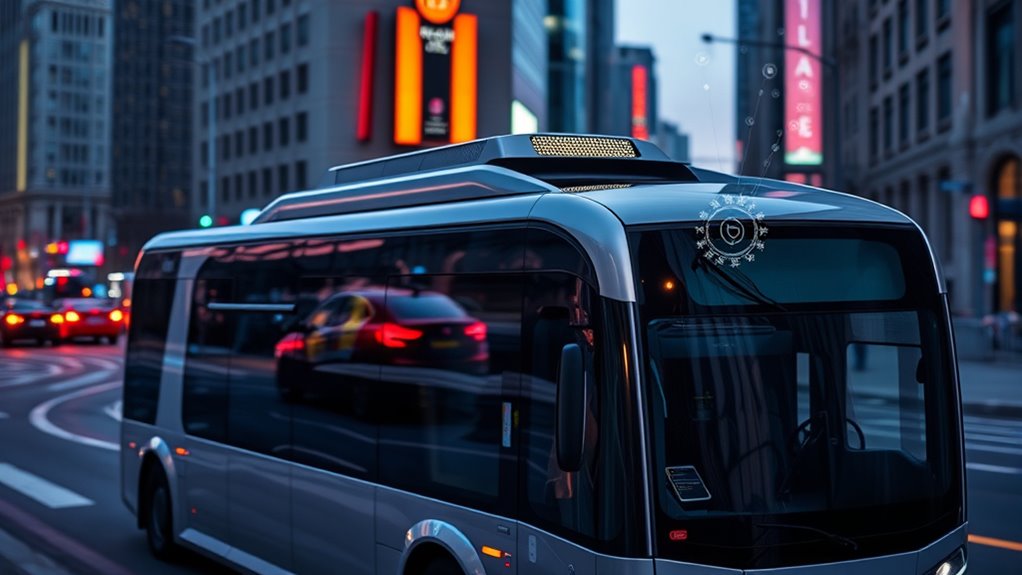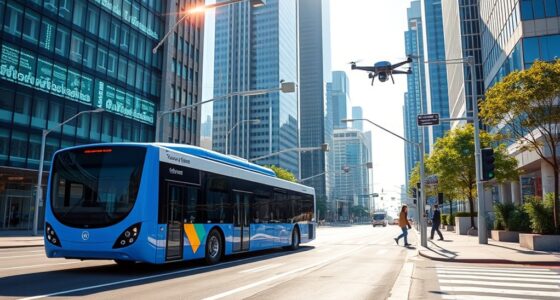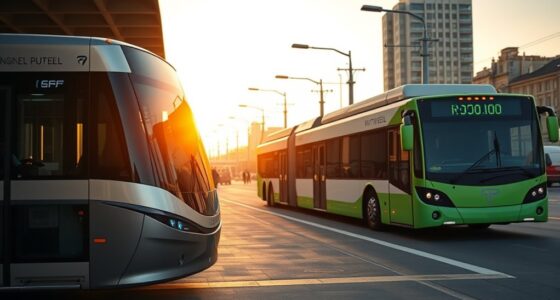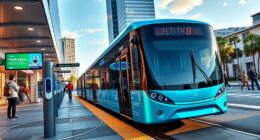Integrating 5G technology into electric bus operations enhances safety, efficiency, and connectivity by enabling real-time data sharing, advanced sensors, and autonomous driving features. This high-speed network supports instant communication between vehicles, infrastructure, and emergency services, while reducing delays through low-latency connections. Global pilot projects showcase how 5G promotes smarter urban mobility and safer public transit. To discover how this technology is shaping sustainable cities, continue exploring the innovative developments transforming electric bus systems.
Key Takeaways
- 5G enables real-time communication and data exchange for enhanced safety, navigation, and obstacle avoidance in electric bus operations.
- Massive connectivity and low latency support Vehicle-to-Everything (V2X) protocols for seamless coordination between buses, infrastructure, and pedestrians.
- Edge AI and MEC facilitate localized data processing, reducing delays and reliance on distant cloud servers for autonomous decision-making.
- 5G integration improves predictive maintenance, fleet management, and urban traffic optimization through continuous data monitoring.
- Deployment requires addressing coverage, signal stability, network capacity, and security challenges to ensure reliable and safe bus operations.
The Role of 5G in Enhancing Electric Bus Safety and Efficiency
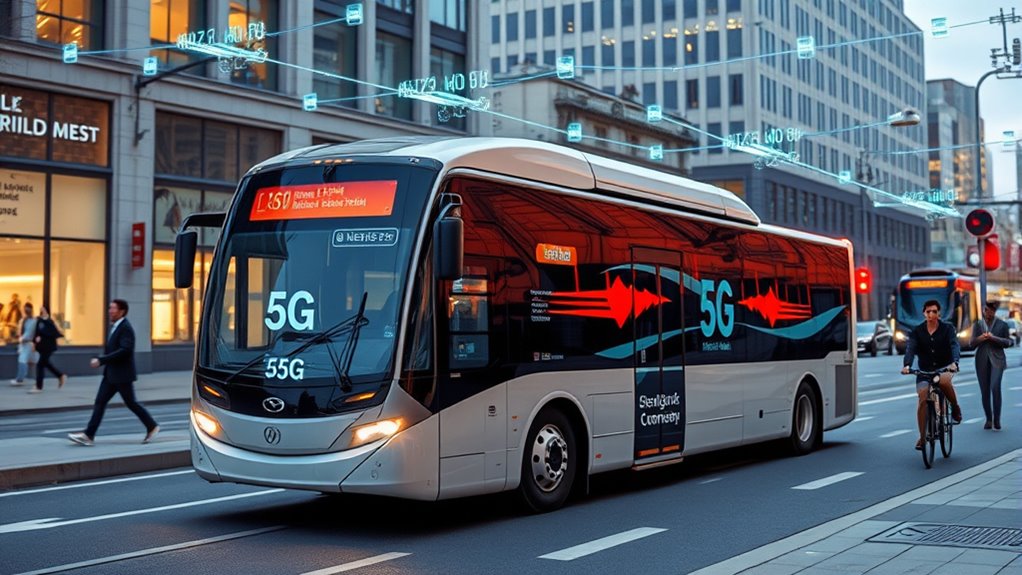
5G plays an essential role in improving both the safety and efficiency of electric bus operations by enabling rapid data exchange and real-time communication. With 5G, you get instant responses to commands and situations, making buses react faster and more safely.
Advanced sensors and AI help buses understand their surroundings immediately, allowing quick decisions to avoid hazards. Data prioritization guarantees safety-critical information is transmitted without delay, especially when obstacles are detected. The integration of high refresh rates ensures that sensor data is updated swiftly, reducing latency and improving overall responsiveness. Additionally, real-time data processing allows for more dynamic and adaptive operational strategies, further enhancing safety measures.
Real-time monitoring capabilities improve threat detection and enable quicker responses to potential security issues, adding an extra layer of safety to the system. Control towers can monitor and manage buses remotely through 5G, providing continuous oversight and quick intervention if needed. When one vehicle encounters an issue, it can instantly share data with others, boosting overall fleet safety.
This seamless data flow ensures safer, more reliable, and efficient electric bus operations across the board. AI-driven safety measures further enhance operational reliability by enabling predictive maintenance and adaptive responses to emerging risks.
Key Features of 5G Networks Supporting Autonomous Transportation
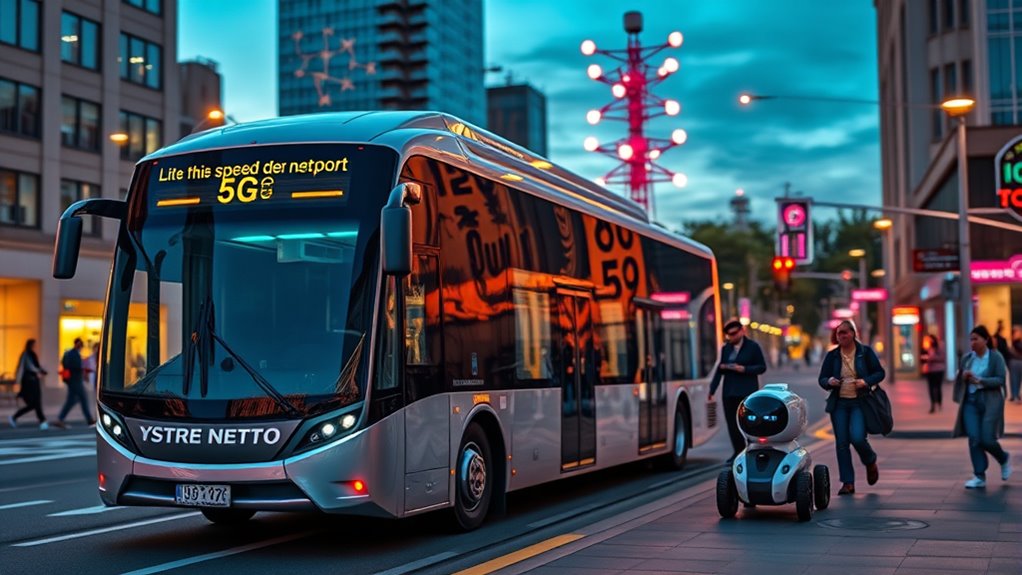
One of the most significant features supporting autonomous transportation is network slicing, which creates virtual networks dedicated to specific applications like self-driving vehicles. This guarantees safety-critical data transmits without delay, even during high network traffic, by isolating autonomous driving communications from infotainment and non-essential services.
Ultra-low latency is another key feature, enabling vehicles to process sensor data and environmental changes instantly, supporting real-time navigation and obstacle avoidance.
Massive connectivity allows thousands of devices, including vehicles, infrastructure, and pedestrians, to communicate simultaneously via V2X protocols, improving situational awareness.
Additionally, integrating Multi-Access Edge Computing (MEC) provides localized, fast data processing, reducing reliance on distant servers.
Combined, these features make 5G networks essential for safe, efficient, and reliable autonomous transportation systems.
Global Initiatives and Pilot Projects in 5G-Enabled Electric Buses
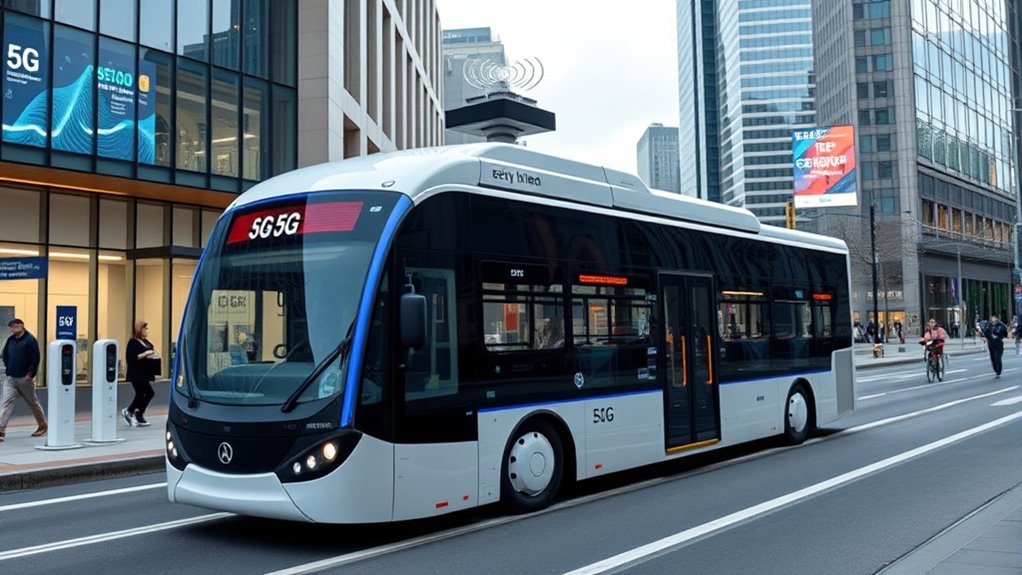
Across the globe, innovative pilot projects are showcasing the potential of 5G technology to transform electric bus services.
In Thailand, the first 5G autonomous electric bus operates in Ayutthaya, steering a route around the historical park at about 30 km/h, with reservations made via an app.
Stockholm’s 5G Ride project tests self-driving electric buses in urban areas, collaborating with Ericsson and Keolis, including trials in Royal Djurgården. These trials employ advanced sensors, radar, and GPS for smooth steering and precise navigation.
Malaysia’s Digital Nasional Berhad partners with Ericsson and eMooVit to develop 5G-enabled safety and user experience enhancements for autonomous buses.
These projects use sensors, radar, and GPS for smooth steering.
The integration of 5G also raises important considerations regarding privacy and cookies, ensuring that data collected during these operations complies with privacy standards and user consent protocols. Future plans include integrating with smart city infrastructure and exploring 5G remote driving, pushing the boundaries of autonomous electric bus deployment worldwide. Additionally, understanding wireless communication standards is essential for optimizing connectivity and safety in these autonomous systems. Furthermore, advancements in home decor materials and technology can inspire innovative interior designs for these transit vehicles, enhancing passenger comfort and aesthetic appeal. As 5G networks expand, the importance of cybersecurity measures in protecting autonomous vehicle operations becomes increasingly critical to prevent potential cyber threats.
Technological Components Powering 5G-Connected Bus Systems
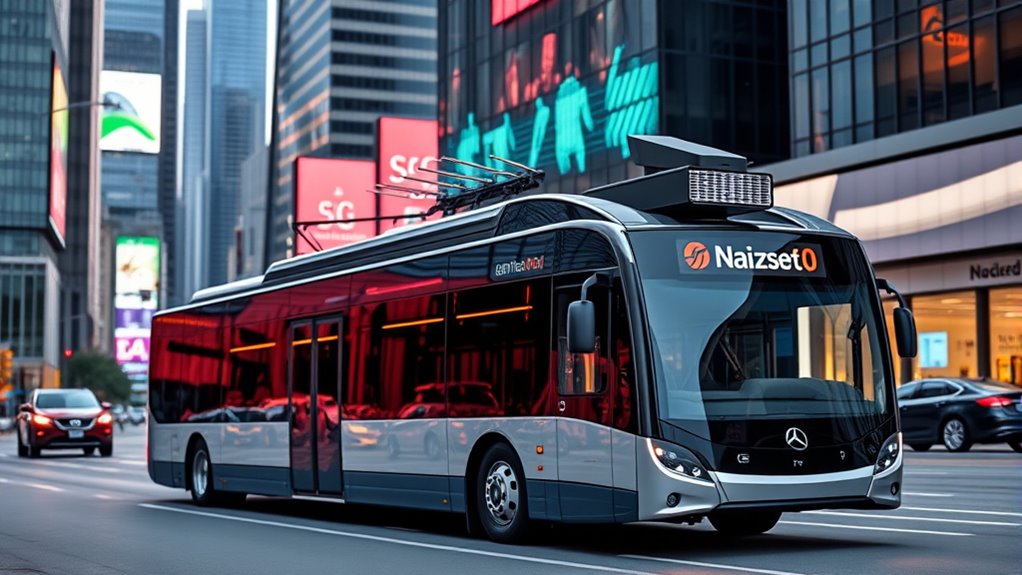
The success of 5G-enabled electric bus systems depends on a sophisticated network infrastructure and advanced vehicle technologies working seamlessly together. You rely on Ericsson’s radio equipment to guarantee high-speed data transfer between buses and control towers.
Telia’s low-latency 5G network supports real-time vehicle-to-infrastructure communication, while modular gateways enable smooth signal switching during bus movement. Incorporating robust network design ensures consistent connectivity even in challenging urban environments. Additionally, implementing advanced security protocols helps safeguard data integrity and prevent malicious cyber threats across the system.
Telia’s 5G network ensures seamless vehicle-to-infrastructure communication with smooth signal switching during bus movement.
Edge computing, through network slicing, prioritizes critical data like obstacle detection, ensuring uninterrupted service. This approach helps optimize operational efficiency and enhances safety measures. A well-planned hybrid infrastructure can also improve overall system resilience and flexibility.
Inside the vehicle, AI-driven sensors and LiDAR facilitate autonomous decision-making, with onboard analytics processing data instantly.
Roof-mounted gateways provide dual Wi-Fi 6/6E access points, supporting passenger connectivity and operational needs.
These components combine to create a reliable, efficient, and scalable system that enhances safety, operational efficiency, and passenger experience. The implementation of reliable train station hours ensures that maintenance and operations are synchronized with the system’s demanding connectivity needs.
Safety and Security Benefits of Using 5G in Public Transit
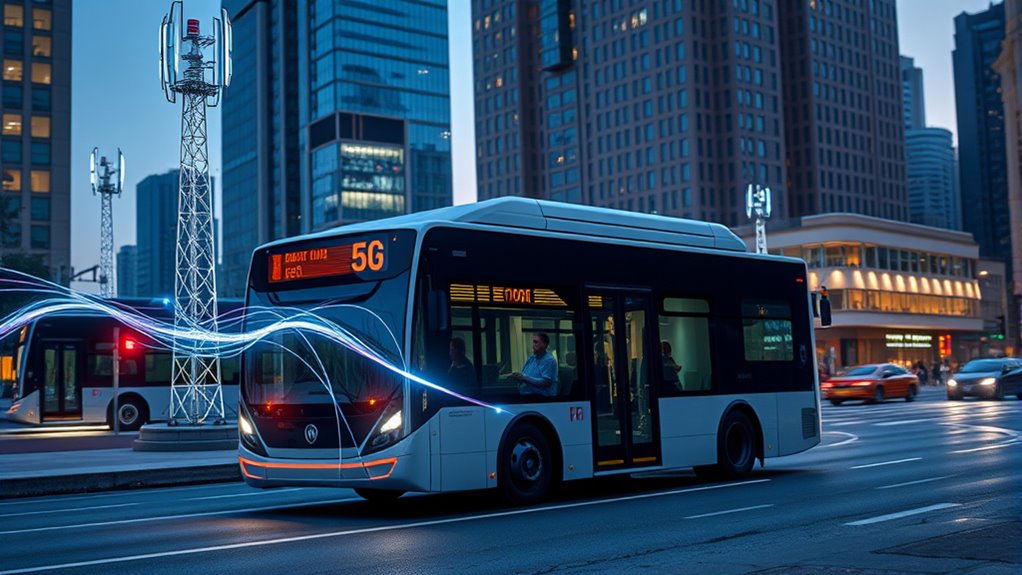
Implementing 5G technology in public transit substantially enhances safety and security by enabling real-time video surveillance, swift emergency responses, and advanced security systems.
With 5G-enabled cameras, you can monitor buses inside and out simultaneously, transmitting HD footage instantly for incident management. Predictive analytics help identify potential safety issues before they happen, while IoT sensors provide crucial data during emergencies, like passenger counts. Additionally, real-time data sharing facilitates coordinated responses among various emergency services, improving overall safety. This seamless connectivity ensures that all relevant parties can access critical information without delays, further strengthening security measures. Moreover, the integration of advanced security protocols ensures data integrity and protection against cyber threats.
This connectivity allows first responders to act faster and more efficiently. Real-time surveillance and security measures deter crime, improve passenger safety, and support proactive maintenance.
Secure data transmission protects sensitive information, and digital signage delivers safety updates instantly. Overall, 5G creates a more secure environment by facilitating seamless communication, rapid responses, and continuous monitoring for public transit systems. Enhanced communication capabilities further optimize safety operations and emergency management strategies.
Innovations and Future Trends in 5G-Integrated Urban Mobility
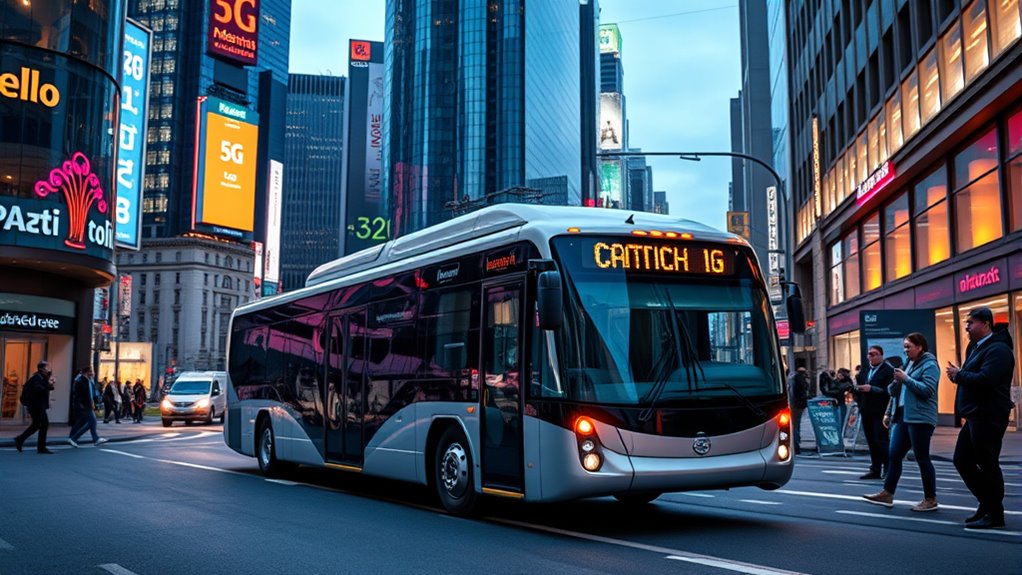
Innovations driven by 5G are transforming urban mobility, offering smarter, more efficient transportation solutions. You’ll see real-time data improve route planning, reducing congestion and wait times.
Autonomous electric buses become more viable, enhancing safety and operational efficiency. Automation technologies are increasingly integrated into transportation systems to streamline operations and reduce human error. Traffic management systems will leverage sensors and cameras to optimize flow and decrease delays, with advanced data analytics playing a key role in predictive traffic control. Additionally, the deployment of high-speed wireless communication ensures reliable connectivity for all connected devices within transportation networks.
Energy efficiency in electric buses will rise by up to 15% thanks to AI-powered 5G systems that optimize battery use. Urban planning will increasingly incorporate 5G to develop sustainable, connected transportation networks.
Future trends point to widespread adoption of autonomous vehicles, AI-driven operations, and smart infrastructure like dedicated lanes and adaptive traffic signals. These innovations will create more seamless, eco-friendly urban transit experiences, transforming how you move through cities. Additionally, the integration of connected infrastructure will facilitate more dynamic and responsive transportation systems, further enhancing urban mobility.
Challenges and Considerations for Implementing 5G in Public Transportation
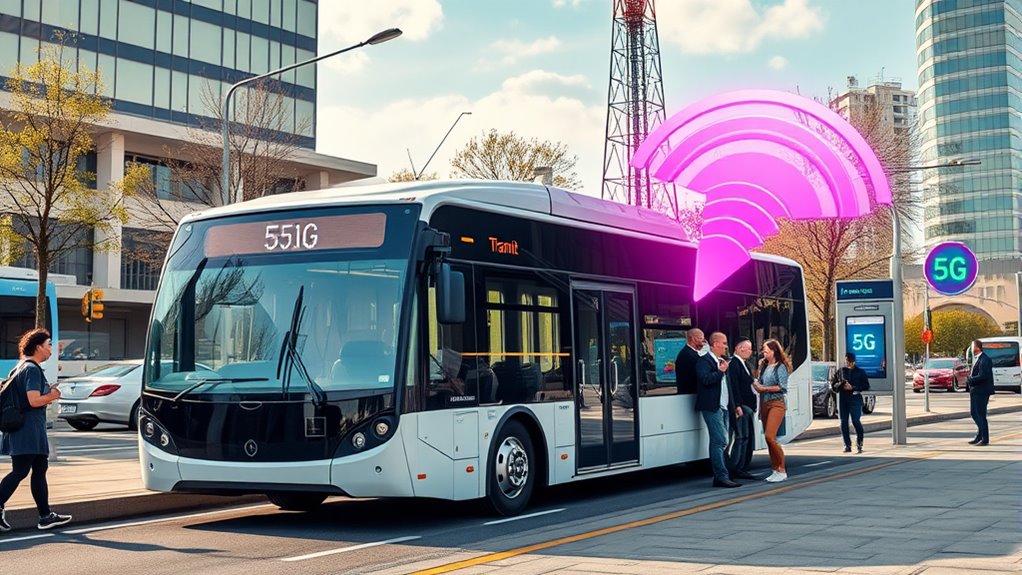
While 5G promises to revolutionize public transportation, deploying it in urban bus networks presents several significant challenges. Signal stability issues arise because buses move at varying speeds and frequently stop, causing frequent handovers between cell towers. Ensuring reliable handovers is vital for continuous connectivity, especially in dense urban areas. Moreover, the variability in signal quality can lead to inconsistent service, impacting operational efficiency. Additionally, the coverage area of 5G signals in urban environments can be limited by dense building structures, which complicates network planning and performance. The complexity of MIMO antennas, sometimes with up to 9×4 configurations, increases installation and maintenance costs. Real-world data rates often fall short of theoretical 5G specs, impacting service reliability during route changes. Network capacity limitations are a common obstacle faced during large-scale 5G rollouts in urban environments. Furthermore, the high density of devices connected to the network can exacerbate congestion issues, especially during peak hours. Additionally, high-resolution surveillance feeds and real-time data from sensors strain network capacity, risking congestion. Infrastructure retrofitting, safety-critical system requirements, and cybersecurity vulnerabilities further complicate deployment. Infrastructure upgrades are often necessary to support the increased data demands and ensure system security. Balancing these technical, financial, and safety considerations is essential for successful 5G integration in public transit.
The Future Impact of 5G on Sustainable and Smart City Development
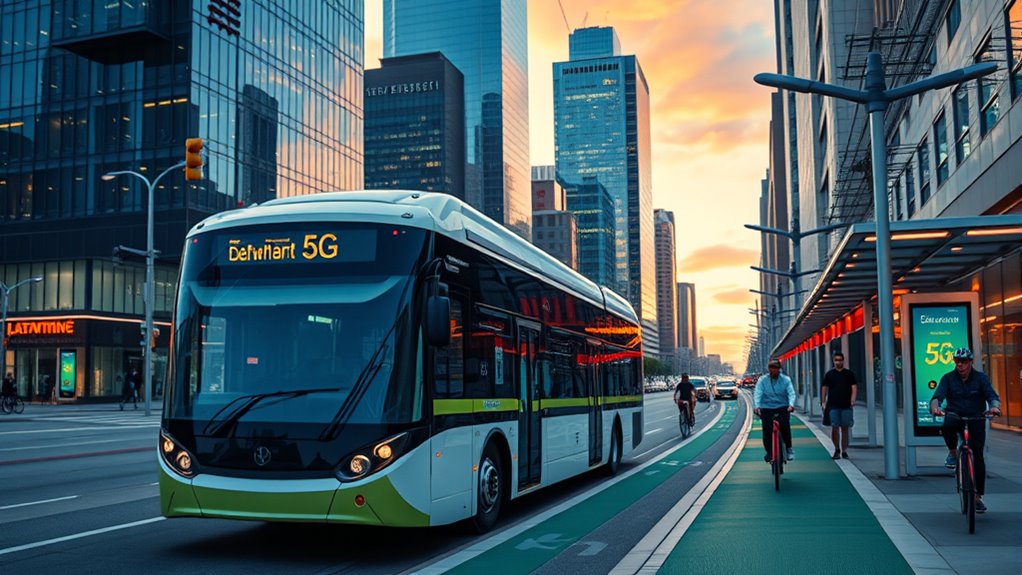
The integration of 5G into public transportation systems is accelerating the development of sustainable and smart cities by enabling advanced IoT networks and real-time urban management. With millions of connected sensors on infrastructure like streetlights, buses, and pipes, you can transmit data instantly, supporting traffic management, predictive maintenance, and emergency responses.
Edge AI processes data locally, reducing delays and cloud dependency. This interconnected ecosystem links transportation, utilities, and healthcare, creating unified city operations.
You benefit from sub-millisecond latency, allowing instant traffic signal adjustments and accident prevention. AI-driven analytics optimize resource use, cut costs, and reduce waste.
Frequently Asked Questions
How Does 5G Improve Autonomous Bus Navigation and Obstacle Detection?
You see, 5G enhances autonomous bus navigation and obstacle detection by providing ultra-low latency, ensuring instant responses to obstacles. Its high bandwidth supports real-time sensor data fusion and HD video streaming.
While network slicing prioritizes safety functions. Beamforming maintains stable connections in dense areas, and cloud-edge-AI integration boosts spatial awareness. Overall, 5G creates a faster, more reliable communication network that helps buses navigate safely and detect obstacles promptly.
What Are the Main Security Risks of 5G in Public Transportation?
Well, isn’t it charming? Your shiny 5G-powered buses could become cyberattack magnets. You face risks like network disruptions, DDoS attacks, and data breaches.
IoT devices expand attack points, and supply chains might hide malicious components. Privacy isn’t safe either—passenger info could be compromised.
How Cost-Effective Is Deploying 5G for Urban Bus Networks?
You’re asking about how cost-effective deploying 5G is for urban bus networks. With infrastructure cost reductions like network densification, slicing, and fiber integration, you save on deployment and maintenance.
Operational efficiency improves through remote management and predictive maintenance, cutting labor and repair costs.
Energy savings come from beamforming and MIMO tech, while scalability ensures long-term ROI.
What Infrastructure Is Needed to Support 5g-Enabled Electric Buses?
You’ll need robust network infrastructure, including 5G RAN deployment with URLLC nodes for real-time V2I data exchange. Network slicing guarantees prioritized traffic, while edge computing reduces latency for critical functions.
High-capacity backhaul links support streaming data, and upgrades like AI-driven RAN optimize performance.
On the vehicle side, onboard 5G modems, sensors, and secure communication protocols are essential, along with smart city systems for traffic management and centralized monitoring.
How Will 5G Influence Future Public Transit System Designs?
Think of 5G as the heartbeat of future transit, pulsing faster and stronger. It will revolutionize system designs by enabling real-time data flows, smarter routing, and seamless multimodal connections.
You’ll see buses operating more efficiently, with predictive maintenance, optimized energy use, and enhanced safety features. Passengers will enjoy instant updates, better comfort, and smarter travel options.
Conclusion
As you embrace the dawn of 5G in electric bus operations, remember it’s more than just technology—it’s the heartbeat of smarter, safer cities. Like a guiding light in the night, 5G illuminates the path toward sustainable urban mobility, connecting communities and fostering innovation. By integrating this power, you help build a future where every journey is safer, greener, and more efficient—turning the city into a living, breathing symbol of progress and hope.
